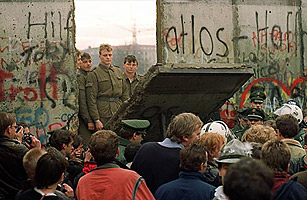
Water cannons didn't stop Berliners from destroying the Wall.
Nov. 9, 1989
"What shall I do? Order you to shoot?" As a crowd of 20,000 of his countrymen implored him to "Open the gate!" on that chaotic Thursday evening, Harald Jäger, head of passport control at the Berlin Wall's Bornholmer Strasse checkpoint, kept shouting that rhetorical question at the guards under his command.
It was nearly 11 p.m., four hours since Jäger heard the stunning news on TV: the East German Politburo, responding to weeks of peaceful demonstrations and a flood of refugees fleeing through Hungary and Czechoslovakia, had announced that all citizens could leave East Germany at any crossing "immediately." Suddenly Jäger, 48, held in his hands the fate of thousands of people — as well as that of the Wall he had so faithfully watched over for all 28 years of its existence. His orders were to turn the protesters back unless they had proper documents, but he knew that attempting to do so would result in bloodshed.
So, as recounted in The Wall: The People's Story, shortly after 11 p.m. Jäger told his men at the gates to "open them all." By dawn, an estimated 100,000 delirious East Germans had slipped past him on their way to a raucous celebration in West Berlin. Over the next few days, the revelers hammered away at the most notorious symbol of Soviet communist repression and toasted their newfound freedom with bottles of champagne. But joy was soon dampened by the daunting burden of rebuilding the backward East. More than a decade after Germany officially unified in 1990, the country is still suffering the hangover.